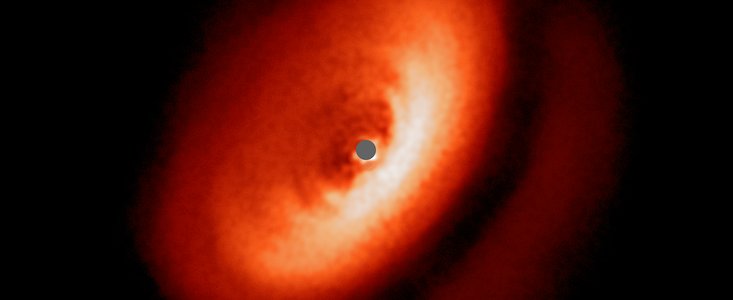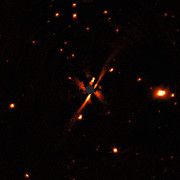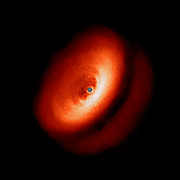Komunikat prasowy
SPHERE pokazuje fascynującą menażerię dysków wokół młodych gwiazd
11 kwietnia 2018

Nowe zdjęcia z instrumentu SPHERE na należącym do ESO teleskopie VLT ukazują pyłowe dyski otaczające pobliskie młode gwiazdy bardziej szczegółowo niż do tej pory. Widać dziwną różnorodność kształtów, rozmiarów i struktur, w tym prawdopodobne efekty od planet będących jeszcze ciągle w trakcie procesów formowania się.
Instrument SPHERE na należącym do ESO Bardzo Dużym Teleskopie (VLT) w Chile pozwala astronomom stłumić jasne światło pobliskich gwiazd, aby uzyskać lepszy widok na obszary wokół nich. Zestaw nowych zdjęć ze SPHERE jest zaledwie próbką dużej różnorodności dysków odkrywanych wokół młodych gwiazd.
Dyski te są w niezmiernym bogactwie rozmiarów i kształtów – niektóre zawierają jasne pierścienie, w innych pierścienie są ciemne, a jeszcze inne np. przypominają hamburgery. Różnią się też znacznie w wyglądzie w zależności od orientacji na niebie – od okrągłych dysków widocznych z góry, po wąskie widoczne prawie z boku.
Podstawowym zadaniem SPHERE jest odkrywanie i badania wielkich egzoplanet krążących wokół pobliskich gwiazd techniką bezpośredniego obrazowania. Ale instrument jest także jednym z najlepszych istniejących narzędzi do uzyskiwania obrazów dysków wokół młodych gwiazd – obszarów, w których mogą formować się planety. Badanie takich dysków jest kluczowe w poszukiwaniu związku pomiędzy własnościami dysku, a powstawaniem i występowaniem planet.
Wiele młodych gwiazd zaprezentowanych tutaj pochodzi z nowego badania gwiazd typu T Tauri, klasy gwiazd, które są bardzo młode (poniżej 10 milionów lat) i zmieniają jasność. Dyski wokół tych gwiazd zawierają gaz, pył i planetozymale – składniki budulcowe planet i poprzedniczki systemów planetarnych.
Zdjęcia pokazują także jak nasz Układ Słoneczny mógł wyglądać we wczesnych etapach formowania się, ponad cztery miliardy lat temu.
Większość pokazanych zdjęć została uzyskana w ramach przeglądu DARTTS-S (Discs ARound T Tauri Stars with SPHERE). Odległości do obiektów mieszczą się w przedziale od 230 do 550 lat świetlnych od Ziemi. Dla porównania, Droga Mleczna mierzy prawie 100 000 lat świetlnych, zatem gwiazdy te są względnie blisko Ziemi. Ale nawet w takich odległości wyzwaniem jest otrzymanie dobrych zdjęć dysków, które bardzo słabo odbijają światło, ponieważ są one przyćmiewane oślepiającym blaskiem swoich gwiazd macierzystych.
Kolejną nową obserwacją SPHERE jest odkrycie widocznego z boku dysku wokół gwiazdy GSC 07396-00759, znalezionego przez przegląd SHINE (SpHere INfrared survey for Exoplanets). Ta czerwona gwiazda należy do układu wielokrotnego, uwzględnionego również w próbce DARTTS-S, ale nowy dysk wydaje się bardziej wyewoluowany niż bogaty w gaz dysk wokół gwiazdy typu T Tauri w tym samym systemie, pomimo iż są w tym samym wieku. Zagadkowa różnica w ewolucyjnych skalach czasowych dysków wokół dwóch gwiazd w tym samym wieku jest kolejnym powodem, dla którego astronomowie chcieliby się dowiedzieć więcej o dyskach i ich własnościach.
Astronomowie użyli SPHERE o otrzymania wielu innych imponujących obrazów, a także do innych badań, m.in. oddziaływań pomiędzy planetą, a dyskiem, ruchów orbitalnych w układzie, czy ewolucji dysku w czasie.
Nowe wyniki ze SPHERE, razem z danymi z innych teleskopów, takich jak ALMA, rewolucjonizują zrozumienie przez astronomów środowiska wokół młodych gwiazd i złożonych mechanizmów formowania planet.
Więcej informacji
Zdjęcia dysków wokół gwiazd typu T Tauri zostały zaprezentowane w artykule pt. „Disks Around T Tauri Stars With SPHERE (DARTTS-S) I: SPHERE / IRDIS Polarimetric Imaging of 8 Prominent T Tauri Disks”, H. Avenhaus et al., który ukaże się w „Astrophysical Journal”. Odkrycie ustawionego bokiem dysku zostało z kolei zaraportowane w artykule pt. „A new disk discovered with VLT/SPHERE around the M star GSC 07396-00759”, E. Sissa et al., który ukaże się w czasopiśmie Astronomy & Astrophysics.
Skład zespołu badawczego: Henning Avenhaus (Max Planck Institute for Astronomy, Heidelberg, Niemcy; ETH Zurich, Institute for Particle Physics and Astrophysics, Zurich, Switzerland; Universidad de Chile, Santiago, Chile), Sascha P. Quanz (ETH Zurich, Institute for Particle Physics and Astrophysics, Zurich, Szwajcaria; National Center of Competence in Research “PlanetS”), Antonio Garufi (Universidad Autonónoma de Madrid, Madryd, Hiszpania), Sebastian Perez (Universidad de Chile, Santiago, Chile; Millennium Nucleus Protoplanetary Disks Santiago, Chile), Simon Casassus (Universidad de Chile, Santiago, Chile; Millennium Nucleus Protoplanetary Disks Santiago, Chile), Christophe Pinte (Monash University, Clayton, Australia; Univ. Grenoble Alpes, CNRS, IPAG, Grenoble, Francja), Gesa H.-M. Bertrang (Universidad de Chile, Santiago, Chile), Claudio Caceres (Universidad Andrés Bello, Santiago, Chile), Myriam Benisty (Unidad Mixta Internacional Franco-Chilena de Astronomía, CNRS/INSU; Universidad de Chile, Santiago, Chile; Univ. Grenoble Alpes, CNRS, IPAG, Grenoble, Francja) oraz Carsten Dominik (Anton Pannekoek Institute for Astronomy, University of Amsterdam, Holandia).
Skład drugiego zespołu: E. Sissa (INAF-Osservatorio Astronomico di Padova, Padwa, Włochy), J. Olofsson (Max Planck Institute for Astronomy, Heidelberg, Niemcy; Universidad de Valparaíso, Valparaíso, Chile), A. Vigan (Aix-Marseille Université, CNRS, Laboratoire d’Astrophysique de Marseille, Marseille, Francja), J.C. Augereau (Université Grenoble Alpes, CNRS, IPAG, Grenoble, Francja) , V. D’Orazi (INAF-Osservatorio Astronomico di Padova, Padwa, Włochy), S. Desidera (INAF-Osservatorio Astronomico di Padova, Padwa, Włochy), R. Gratton (INAF-Osservatorio Astronomico di Padova, Padwa, Włohy), M. Langlois (Aix-Marseille Université, CNRS, Laboratoire d’Astrophysique de Marseille Marseille, Francja; CRAL, CNRS, Université de Lyon, Ecole Normale Suprieure de Lyon, Francja), E. Rigliaco (INAF-Osservatorio Astronomico di Padova, Padwa, Włochy), A. Boccaletti (LESIA, Observatoire de Paris-Meudon, CNRS, Université Pierre et Marie Curie, Université Paris Diderot, Meudon, Francja), Q. Kral (LESIA, Observatoire de Paris-Meudon, CNRS, Université Pierre et Marie Curie, Université Paris Diderot, Meudon, Francja; Institute of Astronomy, University of Cambridge, Cambridge, Wielka Brytania), C. Lazzoni (INAF-Osservatorio Astronomico di Padova, Padwa, Włochy; Universitá di Padova, Padwa, Włochy), D. Mesa (INAF-Osservatorio Astronomico di Padova, Padwa, Włochy; University of Atacama, Copiapo, Chile), S. Messina (INAF-Osservatorio Astrofisico di Catania, Catania, Francja), E. Sezestre (Université Grenoble Alpes, CNRS, IPAG, Grenoble, Francja), P. Thébault (LESIA, Observatoire de Paris-Meudon, CNRS, Université Pierre et Marie Curie, Université Paris Diderot, Meudon, Francja), A. Zurlo (Universidad Diego Portales, Santiago, Chile; Unidad Mixta Internacional Franco-Chilena de Astronomia, CNRS/INSU; Universidad de Chile, Santiago, Chile; INAF-Osservatorio Astronomico di Padova, Padwa, Włochy), T. Bhowmik (Université Grenoble Alpes, CNRS, IPAG, Grenoble, Francja), M. Bonnefoy (Université Grenoble Alpes, CNRS, IPAG, Grenoble, Francja), G. Chauvin (Université Grenoble Alpes, CNRS, IPAG, Grenoble, Francja; Universidad Diego Portales, Santiago, Chile), M. Feldt (Max Planck Institute for Astronomy, Heidelberg, Niemcy), J. Hagelberg (Université Grenoble Alpes, CNRS, IPAG, Grenoble, Francja), A.-M. Lagrange (Université Grenoble Alpes, CNRS, IPAG, Grenoble, Francja), M. Janson (Stockholm University, Stockholm, Szwecja; Max Planck Institute for Astronomy, Heidelberg, Niemcy), A.-L. Maire (Max Planck Institute for Astronomy, Heidelberg, Niemcy), F. Ménard (Université Grenoble Alpes, CNRS, IPAG, Grenoble, Francja), J. Schlieder (NASA Goddard Space Flight Center, Greenbelt, Maryland, USA; Max Planck Institute for Astronomy, Heidelberg, Niemcy), T. Schmidt (Université Grenoble Alpes, CNRS, IPAG, Grenoble, Francja), J. Szulági (Institute for Particle Physics and Astrophysics, ETH Zurich, Zurich, Szwajcaria; Institute for Computational Science, University of Zurich, Zurich, Szwajcaria), E. Stadler (Université Grenoble Alpes, CNRS, IPAG, Grenoble, Francja), D. Maurel (Université Grenoble Alpes, CNRS, IPAG, Grenoble, Francja), A. Deboulbé (Université Grenoble Alpes, CNRS, IPAG, Grenoble, Francja), P. Feautrier (Université Grenoble Alpes, CNRS, IPAG, Grenoble, Francja), J. Ramos (Max Planck Institute for Astronomy, Heidelberg, Niemcy) oraz R. Rigal (Anton Pannekoek Institute for Astronomy, Amsterdam, Holandia).
ESO jest wiodącą międzyrządową organizacją astronomiczną w Europie i najbardziej produktywnym obserwatorium astronomicznym na świecie. Ma 15 krajów członkowskich: Austria, Belgia, Czechy, Dania, Finlandia, Francja, Hiszpania, Holandia, Niemcy, Polska, Portugalia, Szwajcaria, Szwecja, Wielka Brytania oraz Włochy, dodatkowo Chile jest kraje gospodarzem, a Australia strategicznym partnerem. ESO prowadzi ambitne programy dotyczące projektowania, konstrukcji i użytkowania silnych naziemnych instrumentów obserwacyjnych, pozwalając astronomom na dokonywanie znaczących odkryć naukowych. ESO odgrywa wiodącą rolę w promowaniu i organizowaniu współpracy w badaniach astronomicznych. ESO zarządza trzema unikalnymi, światowej klasy obserwatoriami w Chile: La Silla, Paranal i Chajnantor. W Paranal ESO posiada teleskop VLT (Very Large Telescope - Bardzo Duży Teleskop), najbardziej zaawansowane na świecie astronomiczne obserwatorium w świetle widzialnym oraz dwa teleskopy do przeglądów. VISTA pracuje w podczerwieni i jest największym na świecie instrumentem do przeglądów nieba, natomiast VLT Survey Telescope to największy teleskop dedykowany przeglądom nieba wyłącznie w zakresie widzialnym. ESO jest głównym partnerem ALMA, największego istniejącego projektu astronomicznego. Z kolei na Cerro Armazones, niedaleko Paranal, ESO buduje 39-metrowy teleskop ELT (Extremely Large Telescope - Ekstremalnie Wielki Teleskop), który stanie się „największym okiem świata na niebo”.
Linki
- Publikacja naukowa (Avenhaus et al.)
- Publikacja naukowa (Sissa et al.)
- Witryna konsorcjum SPHERE
- Zdjęcia VLT
- Zdjęcia SPHERE
Kontakt
Henning Avenhaus
Max Planck Institute for Astronomy
Heidelberg, Germany
E-mail: havenhaus@gmail.com
Elena Sissa
INAF - Astronomical Observatory of Padova
Padova, Italy
E-mail: elena.sissa@inaf.it
Richard Hook
ESO Public Information Officer
Garching bei München, Germany
Tel.: +49 89 3200 6655
Tel. kom.: +49 151 1537 3591
E-mail: rhook@eso.org
Krzysztof Czart (Kontakt dla mediów Polska)
Sieć Popularyzacji Nauki ESO
oraz Urania - Postępy Astronomii
Toruń, Polska
Tel.: +48 513 733 282
E-mail: eson-poland@eso.org
O komunikacie
| Komunikat nr: | eso1811pl |
| Nazwa: | GSC 07396-00759 |
| Typ: | Milky Way : Star : Circumstellar Material : Disk |
| Facility: | Very Large Telescope |
| Instrumenty: | SPHERE |
| Science data: | 2018ApJ...863...44A 2018A&A...613L...6S |
Our use of Cookies
We use cookies that are essential for accessing our websites and using our services. We also use cookies to analyse, measure and improve our websites’ performance, to enable content sharing via social media and to display media content hosted on third-party platforms.
ESO Cookies Policy
The European Organisation for Astronomical Research in the Southern Hemisphere (ESO) is the pre-eminent intergovernmental science and technology organisation in astronomy. It carries out an ambitious programme focused on the design, construction and operation of powerful ground-based observing facilities for astronomy.
This Cookies Policy is intended to provide clarity by outlining the cookies used on the ESO public websites, their functions, the options you have for controlling them, and the ways you can contact us for additional details.
What are cookies?
Cookies are small pieces of data stored on your device by websites you visit. They serve various purposes, such as remembering login credentials and preferences and enhance your browsing experience.
Categories of cookies we use
Essential cookies (always active): These cookies are strictly necessary for the proper functioning of our website. Without these cookies, the website cannot operate correctly, and certain services, such as logging in or accessing secure areas, may not be available; because they are essential for the website’s operation, they cannot be disabled.
Functional Cookies: These cookies enhance your browsing experience by enabling additional features and personalization, such as remembering your preferences and settings. While not strictly necessary for the website to function, they improve usability and convenience; these cookies are only placed if you provide your consent.
Analytics cookies: These cookies collect information about how visitors interact with our website, such as which pages are visited most often and how users navigate the site. This data helps us improve website performance, optimize content, and enhance the user experience; these cookies are only placed if you provide your consent. We use the following analytics cookies.
Matomo Cookies:
This website uses Matomo (formerly Piwik), an open source software which enables the statistical analysis of website visits. Matomo uses cookies (text files) which are saved on your computer and which allow us to analyze how you use our website. The website user information generated by the cookies will only be saved on the servers of our IT Department. We use this information to analyze www.eso.org visits and to prepare reports on website activities. These data will not be disclosed to third parties.
On behalf of ESO, Matomo will use this information for the purpose of evaluating your use of the website, compiling reports on website activity and providing other services relating to website activity and internet usage.
Matomo cookies settings:
Additional Third-party cookies on ESO websites: some of our pages display content from external providers, e.g. YouTube.
Such third-party services are outside of ESO control and may, at any time, change their terms of service, use of cookies, etc.
YouTube: Some videos on the ESO website are embedded from ESO’s official YouTube channel. We have enabled YouTube’s privacy-enhanced mode, meaning that no cookies are set unless the user actively clicks on the video to play it. Additionally, in this mode, YouTube does not store any personally identifiable cookie data for embedded video playbacks. For more details, please refer to YouTube’s embedding videos information page.
Cookies can also be classified based on the following elements.
Regarding the domain, there are:
- First-party cookies, set by the website you are currently visiting. They are stored by the same domain that you are browsing and are used to enhance your experience on that site;
- Third-party cookies, set by a domain other than the one you are currently visiting.
As for their duration, cookies can be:
- Browser-session cookies, which are deleted when the user closes the browser;
- Stored cookies, which stay on the user's device for a predetermined period of time.
How to manage cookies
Cookie settings: You can modify your cookie choices for the ESO webpages at any time by clicking on the link Cookie settings at the bottom of any page.
In your browser: If you wish to delete cookies or instruct your browser to delete or block cookies by default, please visit the help pages of your browser:
Please be aware that if you delete or decline cookies, certain functionalities of our website may be not be available and your browsing experience may be affected.
You can set most browsers to prevent any cookies being placed on your device, but you may then have to manually adjust some preferences every time you visit a site/page. And some services and functionalities may not work properly at all (e.g. profile logging-in, shop check out).
Updates to the ESO Cookies Policy
The ESO Cookies Policy may be subject to future updates, which will be made available on this page.
Additional information
For any queries related to cookies, please contact: pdprATesoDOTorg.
As ESO public webpages are managed by our Department of Communication, your questions will be dealt with the support of the said Department.



